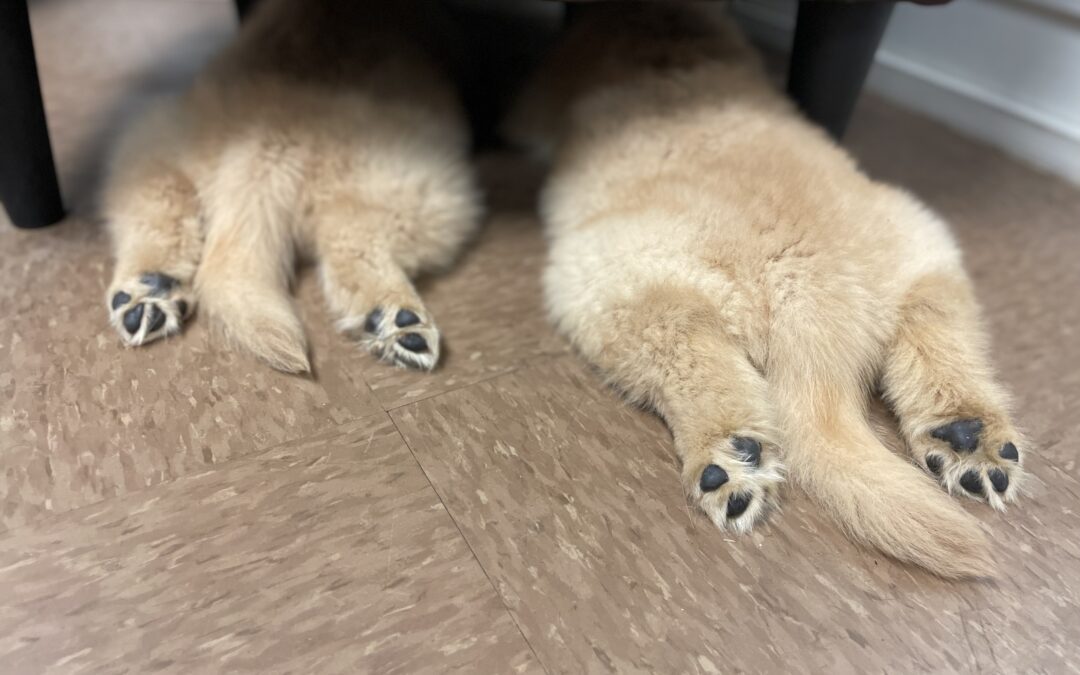As the Fourth of July approaches, I’m looking forward to cookouts, fireworks, and time with friends. I’ll bet most of you are too. But if your pet has noise phobia, the Fourth can bring a sense of dread, because your furry companion is facing several nights of terror.
Noise phobia is intense fear/anxiety in response to loud sounds such as thunderstorms, fireworks, or even household appliances. The causes of noise phobias vary, but they often stem from genetic predisposition, a lack of exposure to noises during critical puppy periods, and traumatic experiences.
Symptoms of noise phobias can range from trembling, panting, and hiding to destructive behavior and attempts to escape. If not treated, noise phobias can significantly impact your pet’s quality of life and lead to long-term behavioral issues, and can be quite costly if your pet is destructive or panics enough to injure him/herself.
Similarly, if your pet has veterinary phobias, a trip to see me at the vet office, or a trip to the groomer for a routine nail trim can turn into a nightmare ordeal of panic and stress.
The sights, sounds, and smells of the veterinary clinic can trigger anxiety in many animals, leading to stress for both you and your pet. This fear can make routine check-ups and necessary medical procedures difficult, potentially compromising your pet’s health and well-being.
Veterinary fear in pets can stem from previous negative experiences, lack of socialization with veterinary environments, or underlying anxiety disorders. The signs of fear can range from subtle (freezing, yawning, lip-licking) to more obvious (trembling, vocalization, aggression, or attempts to flee).
The good news is that there are plenty of tricks and tools you can use to help transform these situations into calm and even happy experiences. Here are some proven strategies:
For veterinary/grooming visits:
1. Choose a vet or groomer who is Fear Free Certified. These professionals have extra training in how to make the experience as calm as possible.
2. Bring treats that your pet likes and is familiar with. Ideally these should be in small pieces to allow for multiple rewards throughout the visit.
3. Schedule your appointment when it’s less busy (ideally mid-morning or mid-afternoon) and call from your car when you arrive to ensure the lobby is clear so that your pet can move calmly into an exam room.
4. Ask for extended appointment time. This allows your pet to acclimate to our staff before the “hands on” part of the visit, and allows us to move more slowly/calmly and adapt to the needs of your pet.
5. Schedule some “happy drop-in visits.” These are visits where you and your pet come into the office, get some treats, and then leave without any bad things happening.
6. Practice with “pretend” veterinary visits at home. When your pet is calm and happy, open its mouth, check its ears and put your fingers in its ears, look between its toes, and feel its abdomen. You can even touch the toenails with a nail clipper. Be sure to use lots of rewards and stop if your pet is showing signs of stress.
For noise phobias:
7. Use white noise (a fan works well) and/or calming music (both classical and reggae have been shown to help) in a comfortable interior room during thunderstorms/fireworks/vet visits to help block out loud scary noises.
8. Stay with your pet and offer treats and games during scary noises, but don’t overly coddle your pet. Your pet takes cues from you, so have a “it’s no big deal” attitude and stay positive.
9. Gradually expose your pet to recorded thunderstorm/firework noises. Start with soft sounds on a bright, sunny day and work up to louder sounds on a cloudy night. Reward your pet with treats/play during this training. This will help reduce fear over time and help your pet feel more comfortable and relaxed.
For all scary situations:
10. Use calming aids. Pheromone collars and sprays such as Adaptil (for dogs) and Feliway (for cats), oral supplements such as Zylkene or Solliquin, probiotics such as Calming Care, and even snug-fitting garments like Thundershirts can help pets be more calm. These tools work best when given several hours before the stress.
11. Work with a qualified “Force-Free” animal behaviorist or trainer. These professionals can provide valuable guidance and support in addressing noise phobias and veterinary fear. They offer programs tailored to the individual needs of your pet, and can teach you effective techniques for managing and reducing your companion’s anxiety.
12. Ask your vet for prescription calming medication. Whole Pet offers a range of calming meds, from holistic to conventional. These meds can often reduce fear without causing drunk/wobbly behavior.
Noise phobias and fear of the veterinarian are common challenges faced by many pet owners, but with patience, understanding, and the right approach, you can help your pet conquer his/her fear.. By tuning into your pet and providing a supportive environment, you can help your furry family member feel more at ease and even happy, even on the Fourth of July.

